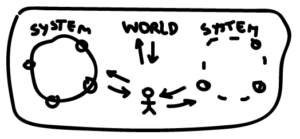Sometimes we still struggle to situate our work in terms of gamification or game design. If gamification is a design process, then game design is also a design process. As known, gamification is about non-gaming contexts but serious games is also about non-leisure contexts. The difference is purely the whole vs. parts (i.e. games design elements) discussion. Gamification is about game design elements and serious games are whole systems, but also composed of elements. So, in this scenario, can gamification become the whole system after design? This is so complicated!
This is not a question about the “magic circle”. I think that if we go towards the magic circle definition, then it will depend on what the player defines as “game”. This means that this “magic” could happen at anytime and anywhere. I’ve read a paper saying that “game” could depend on the perception of the player. So if an user interacts with a system that has game “elements”, it is up to him/her to consider it as a game. That could sound plausible, but what about the design process? What makes gamification different? We could talk about purposes and objectives here. Some might say that gamification is about motivating people to change their behaviour, but then, what about games for change? Aren’t they designed for the same purpose?
The discussion could go further. In serious games we might see heroes and stories attached to the medium. Most of the times, they are characters and they “live” in that game. In card or board games, they are there, but in other formats. In gamification, maybe those heroes could be JUST “real” people. They are what they are. It looks like in gamification the context is the actual main element. This is why DEFINING and INTEGRATING the context is one important aspect. Bringing this context to the interaction could make all the difference and probably shortening the bridge between real-digital. This could also make people change their behaviours in a way that everything is integrated.

The line between gamification and game design is still very thin. But maybe if we consider the context as a major influencer, maybe it can become easier to integrate best practices of gamification. And this is not about points, badges and leaderboards.
Some might argue that gamification is about extrinsic rewards. Let’s think. Can games be about extrinsic rewards or just playing and having fun with it? Can serious games be about extrinsic rewards or is it about value and purpose inside the game? Reward is strongly related to the routine that takes us to get that reward. But, again, the reward requires MEANING, it requires integration with a context. This is why Deterding’s paper from 2011, of “situated motivational affordances” could be interesting in this scenario. Thus, mapping the context is crucial.
The whole point, however, is the understanding of the design process. So, what is the difference between gamification and game design? The integration of the context, perhaps. And what is the difference between gamification and serious game design? Context? Ummm. It looks like gamification tends to be employed in existing systems or tasks. Hence, the verb “gamify” – which I don’t like that much. I think that maybe the problem is in there. Serious game design sounds like the design process is starting from scratch, whereas gamification sounds like we are adjusting an existing interaction. Maybe this implies the integration of CONTEXT and improvement or creation of systems.
There is also the concept of gameful design, which is actual making things more like a game (i.e. gamefulness), rather than just playfulness. In September 2011, Deterding et al. came up with an interesting way to see gamification. It is about the strategy (gamification), being different from a design “goal” (gameful design).
“Gameful design and “gamification” frame the same extension of phenomena through different intensional properties – as the design strategy of using game design elements (gamification) or the design goal of designing for gamefulness (gameful design)” – Deterding et al. (2011)
This discussion could be going on and on, forever, like the chicken-egg issue. Gameful design and gamification sound very similar! It is also hard to define those approaches. Isn’t the goal of gamification to transform things more like a game? Maybe the name is the issue. As I said before, gamification sounds like adjusting existing things and transforming elements into game design elements. Gameful design sounds more like people centred. It is and it will be about PEOPLE. So, what is game design, gamification and gameful design for you? To me, it is a bit like the drawing. Serious game design/game design has a system with defined lines and objects. Gamification has thin lines and real/digital are in the same context. Gameful design is a way to understand people’s needs and abilities in this scenario that involves people’s interaction with a context.
Definitions of gamification and gameful design are still in development. As a researcher, you need to define those terms before starting your work. This is hard and it has been a journey to me. Now I think I can get the idea of this concept. And you? What do you think?
References:
Deterding, S., Sicart, M., Nacke, L., O’Hara, K., & Dixon, D. (2011, May). Gamification. using game-design elements in non-gaming contexts. In CHI’11 Extended Abstracts on Human Factors in Computing Systems (pp. 2425-2428). ACM.
Deterding, S. (2011, May). Situated motivational affordances of game elements: A conceptual model. In Gamification: Using Game Design Elements in Non-Gaming Contexts, a workshop at CHI.
Huotari, K., & Hamari, J. (2012, October). Defining gamification: a service marketing perspective. In Proceeding of the 16th International Academic MindTrek Conference (pp. 17-22). ACM.
Deterding, S., Dixon, D., Khaled, R., & Nacke, L. (2011, September). From game design elements to gamefulness: defining gamification. In Proceedings of the 15th international academic MindTrek conference: Envisioning future media environments (pp. 9-15). ACM.